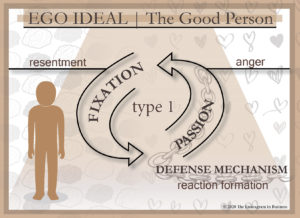Ego ideal is how a person wants to be perceived by self and others, an idealized self that seeks to be continuously reinforced. In a sense, the ego ideal is the aspirational self, whereas the ego-structure includes far more than only ego-ideal, with additional elements such as the type-based fixations, passions, false reality, worldview, deepest longings and more.
Fixations and passions are the ongoing states of functioning (mental and emotional respectively) that continuously play and replay in our Mental Center and our Emotional Center, thus fueling our emotional response patterns. The specific fixations and passions that go with each type create a self-reinforcing loop that become a core element of the each type’s ego structure.
Defense mechanisms are unconscious psychological strategies we use to deal with uncomfortable, difficult and anxiety producing situations. These mechanisms to reduce a person’s fear, sadness, and/or anger and to also maintain his or her self-concept and ego structure, appearing primarily when a person is either avoiding something or experiencing a threat of some sort. Although individuals of all Enneagram types use a variety of defense mechanisms at different times, there is one specific defense mechanisms that is most strongly associated with each type.
This blog series describes how the primary defense mechanism for each Enneagram type functions as a guardian of the type-based ego structure.
ONES’ Ego-Ideal | The good person |always moral and responsible; never bad or mediocre
ONES’ Fixation | Resentment | Continuously paying attention to flaws so that nothing ever seems good enough
ONES’ Passion | Anger | Feelings of chronic dissatisfaction with how thing are
The One’s Primary Defense Mechanism: Reaction Formation
Reaction formation is a defense mechanism by which Ones try to reduce or eliminate anxiety caused by their own thoughts, feelings, or behaviors that they consider unacceptable; they do this by responding in a manner that is the exact opposite of their real responses. Because the One’s active inner judge dictates what is acceptable based on social mores, contextual expectations, and moral principles, reaction formation becomes a defensive strategy when Ones have what they deem as “unacceptable” reactions. While their most typically unacceptable reaction is anger, reaction formation can also occur when One’s experience extreme sadness or fear.
Reaction formation is unconscious and automatic. Although sometimes Ones may know that this behavior is the opposite of the real truth, this realization happens after the fact rather than when reaction formation is occurring. In addition, if Ones do acknowledge that they’ve behaved in a way diametrically opposed to their true feelings, thoughts, and desires, reaction formation also functions to keep them from feeling embarrassed or engaging in negative self-judgments about having done so.
Reaction formation examples
A subtle example often seen in Ones is when they dislike someone, yet are especially nice and polite to this person. A more blatant example – one that is not exclusive to Enneagram style Ones – is an individual who crusades against corporate corruption, only to be discovered later as having embezzled money from the organization.
How reaction formation serves as a guardian of the Type One Ego structure
The type One ego-structure needs to maintain its idealized self of being the good person who never makes mistakes and is more prefect than others. To this end, the One’s fixation of resentment constantly has them noticing flaws and mistakes so that these can be corrected, which then generates their passion, feelings of anger about these errors which is their fuel to take action. Their anger then fuels more resentment and so the loop continues and the ego is in full operation. But the loop also works in reverse, where feelings of anger swirl, which activates resentful thoughts that nothing is ever good enough. Again, the One ego-structure is in full throttle.
But wait! The Ones’ ego ideal is that of a very good person who is polite, well-mannered people and, in their view, people who are polite do not get angry. However, Ones are a double anger type; anger is both their emotional passion and the central emotion of the Body Center from which Ones are formed.
Here is where reaction formation supports the one’s ego ideal and ego structure. When Ones are very angry and they can’t control it as they normally do, reaction formation allows them to both not experience their anger and to not even give off cues that they are, in fact, very angry. This allows their ego ideal and ego structure to remain unchallenged by having to examine their deeply-held anger and rage.
Special note: the ego-idea names and basic descriptions are from the work of Jerry Wagner PhD.
Ginger Lapid-Bogda PhD, the author of seven Enneagram-business books, is a speaker, consultant, trainer, and coach. She provides certification programs and training tools for business professionals around the world who want to bring the Enneagram into organizations with high-impact business applications, and is past-president of the International Enneagram Association. Visit: TheEnneagramInBusiness.com | ginger@theenneagraminbusiness.com


Comments are closed.